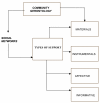Implementation of an active aging model in Mexico for prevention and control of chronic diseases in the elderly
- PMID: 19706199
- PMCID: PMC2739527
- DOI: 10.1186/1471-2318-9-40
Implementation of an active aging model in Mexico for prevention and control of chronic diseases in the elderly
Abstract
Background: World Health Organization cites among the main challenges of populational aging the dual disease burden: the greater risk of disability, and the need for care. In this sense, the most frequent chronic diseases during old age worldwide are high blood pressure, type 2 diabetes mellitus, cancer, arthritis, osteoporosis, depression, and dementia. Chronic disease-associated dependency represents an onerous sanitary and financial burden for the older adult, the family, and the health care system. Thus, it is necessary to propose community-level models for chronic disease prevention and control in old age. The aim of the present work is to show our experience in the development and implementation of a model for chronic disease prevention and control in old age at the community level under the active aging paradigm.
Methods/design: A longitudinal study will be carried out in a sample of 400 elderly urban and rural-dwelling individuals residing in Hidalgo State, Mexico during five years. All participants will be enrolled in the model active aging. This establishes the formation of 40 gerontological promoters (GPs) from among the older adults themselves. The GPs function as mutual-help group coordinators (gerontological nuclei) and establish self-care and self-promotion actions for elderly well-being and social development. It will be conformed a big-net of social network of 40 mutual-help groups of ten elderly adults each one, in which self-care is a daily practice for chronic disease prevention and control, as well as for achieving maximal well-being and life quality in old age. Indicators of the model's impact will be (i) therapeutic adherence; (ii) the incidence of the main chronic diseases in old age; (iii) life expectancy without chronic diseases at 60 years of age; (iv) disability adjusted life years lost; (v) years of life lost due to premature mortality, and (vi) years lived with disability.
Discussion: We propose that the implementation of the model active aging framework will permits the empowerment of older adults, which constitutes basic social capital for chronic disease prevention and control in old age.
Figures





References
-
- United Nations . World population ageing 2007. New York: United Nations; 2007.
-
- Instituto Nacional de Estadística Geografía e Informática . II Conteo de población y vivienda 2005. Resultados definitivo. México: INEGI; 2006.
-
- World Health Organization . Active aging: a policy framework. Geneva: WHO; 2002.
-
- United Nations . Report of the Second World Assembly on Aging, Madrid, 8-12 April, 2002. New York: United Nations; 2002.
-
- Menéndez J, Guevara A, Arcia N, León Díaz EM, Marín C, Alfonso JC. Enfermedades crónicas y limitación funcional en adultos mayores: estudio comparativo en siete ciudades de América Latina y el Caribe. Rev Panam Salud Publica. 2005;17:353–361. - PubMed
Publication types
MeSH terms
LinkOut - more resources
Full Text Sources
Medical

